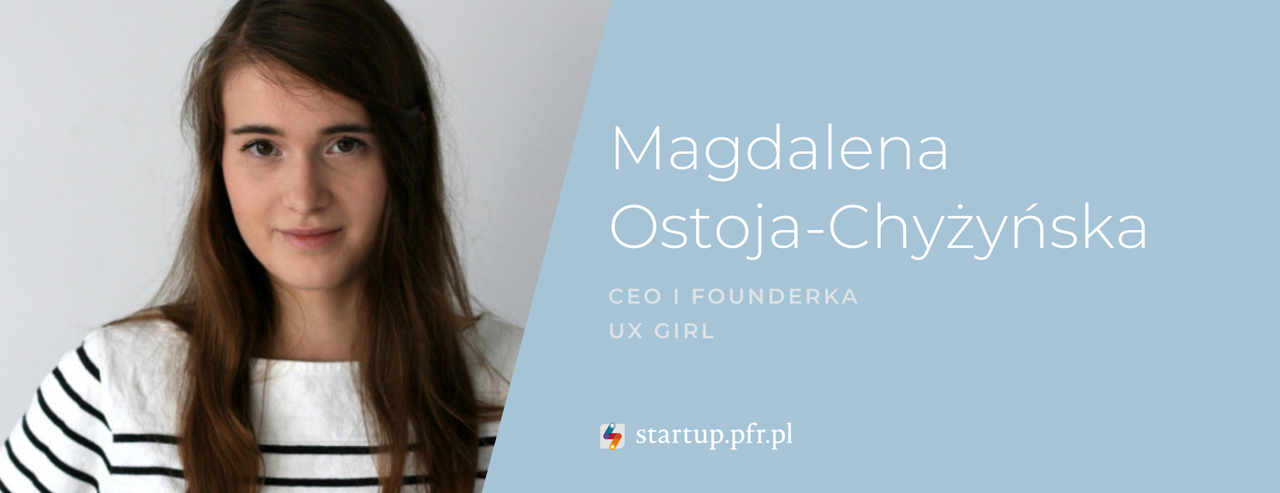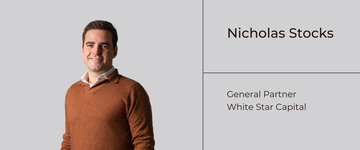"The greater the demand for digital products, the greater the demand for UX" - Magdalena Ostoja - Chyżyńska
As the IT industry grows, more attention is paid not only to the functionality of websites and applications, but also to the needs of people using them. The popularity of the User Experience Designer as a profession of choice is growing. How to become a UX Designer and how to effectively find the needs of people using digital products? These are the question we ask Magdalena Ostoja – Chyżyńska, creator and CEO of UX GIRL and co-organizer of Human Tech Art - a series of meetings with people who implement non-standard ideas using new technologies.
As I have been preparing for our conversation, I have read that you started creating websites at a very young age. Where did your interest in this topic come from and why did you choose to specialize in UX?
It's true, when I was about 11-12 years old, my brother became interested in computer science and writing websites. Then I saw a book about creating websites at his place and, what else there is to say, I was so drawn to it that I never gave it back to him. Within a year, I designed and made six websites myself. My only motivation was that creating these websites gave me great joy, so I devoted my free time to them after school.
This made me want to further develop in this direction, through, among others, the choice of a class with a mathematical and IT profile in high school, and then IT studies. At the university, I came across an interesting science lab called "Human-Computer Interaction". At that time, terms such as "User experience" were not so widely known and the term "human-computer interaction" was used more often. I decided to join this club, and then I became its president, simply because I was very interested in this topic. I have read a lot of materials in the area and I understood that I draw greatest pleasure from collecting requirements, talking to the user and then designing the user interface. Therefore, almost immediately after graduation, I decided that this would be the path I want to develop professionally in.
You have 10 years of experience in UX and UI – how do you perceive changes in the IT market during this time in the context of paying attention to the needs of the user?
There were not so many digital products in the past, but there were "physical" products, such as furniture or various types of household appliances. Therefore, there were designers who created them, and they carried out various types of research and tests with future users as well. So I am sure that the user needs test existed, only in completely different industries. As the large IT market emerged about 10 years ago, there were no UX rules codified. Therefore, I had a feeling, but I think that I was not alone in it, that it was necessary to "hustle" a bit and use books from other sectors to create the principles of the future "User experience".
Now, after these 10 years, we already have a number of written methodologies regarding "user experience". There are many textbooks on the market, and we can easily learn the advanced tools and processes of conducting UX research. In the hindsight, we can see a huge change in this field, but the entire IT market is developing very dynamically, which is why UX cannot stand still either. The company I founded – UX GIRL, which specializes in researching and designing user interfaces, was also created to fill the market gap – there are still not enough UX specialists on the market when comparing the numbers to the existing needs. UX GIRL offers support throughout the process of creating a new product - from product strategy to user research and interface design, as well as the visual layer. Our specialty is simplifying complex user interfaces, and the sectors for which we design are primarily Finance, Enterprise, Health and Science.
Looking back from a more business-oriented perspective, I noticed that 10 years ago, many companies thought that UX was not crucial; that in the case of digital products, there was no need to think about the needs of users. I know examples of companies that currently employ entire departments of people dealing only with UX. 10 years ago they did not see the need to deal with this topic at all. This shows how much the approach to user needs has changed over the years.
The process of creating digital products has also changed a lot. 10 years ago, what mattered most were business issues. Now, of course, it is still not the case that only the needs of the user are important, because business still has its goals to achieve, but they are taken equally seriously. This can be seen, for example, when looking at various methods of software modelling, such as UML or ORM. They only featured business requirements and functionalities, and the user was practically ignored.
You said that your company, UX GIRL, responds to the market demand for specialists in the field of user needs research. Do you think that this sector will continue to grow as dynamically?
The demand for UX services depends solely on how dynamically the entire IT market will develop, and we can all see that this development is not getting slower. We ourselves also become users of an increasing number of products every day. We design what will then be coded and ultimately become a product used by people, so I come to the simple conclusion that the greater the demand for digital products, the greater the demand for UX designers. And from the perspective of the person running the company in this industry, I see growth every year. Our company itself has grown more than twice in the last year.
What competencies are important to effectively investigate user needs? Can UX Designer be a person who has experience in the wider field of humanities?
I will start by saying that I believe that if we want something very much and work hard to do it (because the desire itself might not be enough) – there is a great chance to do it. In addition, I know many humanities students who have become programmers and are great at this profession. Therefore, I would not cross anyone off when it comes to the possibility of working in IT.
Personality is very important. I think a good UX Designer should be inquisitive by nature and have an analytical mind. These features are not only attributed to scientifically inclined minds. Often, interviews with users conducted by people with "arts" experience or education are more exhaustive and deeper. Interpersonal skills are also important in examining user needs.
It is also worth remembering that working in IT is mostly teamwork, which is why these interpersonal competences and the ability to get along with other people will be important in every position. It seems to me that this is a frequently overlooked aspect, and this is one of the most group-oriented industries. At UX GIRL, we always work in matrix structures - on the one hand in a group with developers and product managers, and on the other hand in a design team, where we share knowledge and experience and help each other.
You run UX GIRL – who does your team consist of? And referring to this "girl" in the name of your company - in recent years - in your opinion - has the perception of women in IT changed?
Our team is very diverse in terms of experience and education - we all share a passion for UX, among my colleagues there are both people who have graduated psychology and mathematics. Most of them are women, and there was a time when women made up 100% of our team.
Women existed in the IT industry from the beginning of its existence, but with the development of this market, the number of women in the UX or developer positions naturally increased. Interestingly, there are studies that show that ladies in IT are often better perceived by employers than gentlemen, because they are more meticulous and accountable in their work, which is visible, for example, in annual summaries. Also when I was recruiting for UX GIRL, I just received the best applications from women, which influenced the feminine shape of our team.
And how does your work on user needs research look like?
When it comes to conducting research on the user's needs, usually after receiving information about the product from the customer, we wonder what tools we should use to effectively carry out this process. There is no recipe ready and no clear guidelines on how to test user needs to design a great interface. I think this is what distinguishes experienced UX designers from beginners – the knowledge that creating each product is a completely new process.
What do you think is the best way to start your adventure with UX? Is it worth applying to courses, or can you stop at independent learning?
The first step is to make a clear decision and stick to it consistently. Of course, there are courses, books or even postgraduate studies, but in my opinion, the most important thing is practice. Therefore, in addition to learning the theory, it is also worth to start designing digital products, e.g. by joining non-governmental projects on a voluntary basis. I am convinced that every experience will teach you more than any book.
For such volunteer projects, experience is not required, and it is possible to test the knowledge in practice and obtain valuable material for the portfolio. This is certainly useful during a job interview, as it is worth to present the design process went or tell about the conducted research with users. All this will help you show a possible employer how you think.
Another element that will make it easier to start working in UX is finding a mentor – I did not have one, but I know that many people use the advice and help of more experienced specialists. It's not easy to find a good mentor, but I'm sure it's worth trying.




